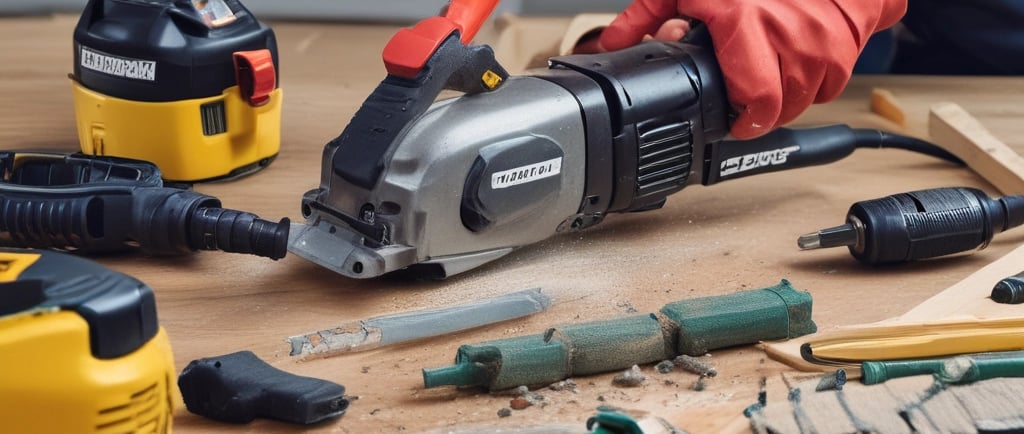Essential Guide to Maintaining and Cleaning Your Black+Decker Tools
BLACK+DECKER GENERALGENERAL BLOG
11/7/20254 min read


Understanding Your Black+Decker Tools
Black+Decker offers a diverse range of tools suited for various tasks, categorizing them primarily into power tools, hand tools, and outdoor equipment. Each category serves distinct purposes and comes with unique characteristics that contribute to effective tool usage. Power tools, such as drills, saws, and sanders, are designed to perform tasks efficiently, leveraging electric power to provide enhanced performance. They are especially useful for larger projects that require precision and speed. Understanding the specifications of these tools can help users select the right tool for the job, ensuring optimal results.
Hand tools, on the other hand, include wrenches, screwdrivers, and pliers, which rely on human power rather than electricity. These tools are essential for both intricate tasks and general repairs, providing versatility in various applications around the home or workshop. Typical issues may include worn-out grips or rusted metal parts, which can be addressed through regular inspections and proper storage practices.
In addition, outdoor equipment from Black+Decker encompasses products such as lawnmowers, trimmers, and blowers. These tools are geared towards maintaining outdoor spaces, with functionality that often varies based on the specific type of equipment. For instance, lawnmowers can be either electric or gas-powered, each with distinct operational characteristics and maintenance needs. Understanding each tool’s typical use cases enhances the user’s ability to maintain them effectively. Regular checks for wear and tear or clogged components are crucial, as outdoor conditions can significantly affect performance.
Familiarizing yourself with the specifics and functionality of your Black+Decker tools is vital. It not only aids in achieving the desired outcomes but also helps in establishing cleaning and maintenance routines tailored to each tool's requirements. Gaining insights into your tools empowers you to prevent common issues, prolong their lifespan, and ensure seamless operation.
Routine Maintenance Tips
Regular maintenance is vital for ensuring the longevity and optimal performance of your Black+Decker tools. By implementing a systematic routine, users can significantly reduce the likelihood of unexpected breakdowns and maintain efficiency in their tasks. The first step in routine maintenance involves conducting thorough inspections for any signs of wear and tear. Tools should be checked frequently, particularly after heavy usage, for any loose or damaged parts that may need attention.
Another critical aspect of maintenance is proper lubrication of the moving components. Lubrication minimizes friction, which can lead to mechanical failure. Using the recommended lubricants for your specific tools will help in maintaining smooth operation. It's advisable to clean the tools before applying lubrication to remove any debris that could impede functionality. Additionally, follow the manufacturer's guidelines regarding intervals for service and lubrication, which usually vary based on tool type and usage frequency.
Moreover, timely replacement of consumables such as blades, batteries, and filters is equally essential. Dull blades can significantly impede work efficiency and increase the risk of accidents. Therefore, it is crucial to monitor their condition and replace them when necessary. Batteries should also be checked regularly for signs of degradation, as this can affect the overall performance of cordless tools. A battery not holding a charge may need replacement to avoid interruptions in work.
As a guideline, it is advisable to create a maintenance checklist. This can include tasks such as inspecting for damage, lubricating moving parts, and replacing consumables on a monthly or bi-monthly basis, depending on usage. By adhering to these routine maintenance tips, users can ensure their Black+Decker tools remain in optimal working condition for years to come.
Cleaning Your Tools – Step-by-Step Guide
Properly cleaning your Black+Decker tools is essential for maintaining their performance and prolonging their lifespan. The process may vary depending on the type of tool you have, but a general step-by-step approach can be applied to most tools. First, gather the necessary cleaning supplies. You will need water, mild soap or a specialized tool cleaner, a soft brush, microfiber cloths, and possibly a lubricant for moving parts. Ensure your workspace is clean and free of debris before you begin the cleaning process.
Start by disconnecting any power source from your tools. This is critical for safety. For electric tools, unplug them, and for battery-operated tools, remove the battery. Once powered down, inspect the tool for any visible dirt or debris. Using a soft brush, gently agitate any loose particles on the exterior. For stubborn grime, prepare a mixture of water and mild soap. Soak a microfiber cloth in the soapy water and wipe down the surfaces of your tool, ensuring that no moisture enters the electronic components.
For blades or cutting tools, use a more targeted approach. Clean the blades with a cloth soaked in a cleaner that can dissolve the specific residues, such as grease or sap. After cleaning, dry the blades thoroughly to prevent rust. Additionally, lubricate any moving parts according to the manufacturer's instructions. This not only enhances performance but also reduces wear and tear.
After cleaning, ensure that all tools are stored in a clean, dry space away from extreme temperatures or moisture. Regularly cleaning your Black+Decker tools and maintaining a tidy workspace are integral practices that safeguard tool integrity and efficiency. Following these steps diligently will help keep your tools in peak condition, ready for use when needed.
Storage Solutions for Longevity
Proper storage solutions play a fundamental role in maintaining the longevity of Black+Decker tools. Investing in appropriate storage options not only protects the tools but also enhances organization and accessibility. Toolboxes are a popular choice, allowing for compact storage of various tools while also providing protection against dust and moisture. Selecting a toolbox that is resistant to corrosion and made from durable materials ensures that tools are safeguarded from external elements that could hasten their wear.
In addition to toolboxes, utilizing racks or wall-mounted solutions can be a highly effective way to store tools. These systems keep tools off the ground, reducing the risk of damage and making it easier to locate them when needed. When considering racks, opt for units that have ample space to accommodate the size of your tools, and ensure they are sturdy enough to support heavier equipment without bending or sagging over time.
Best practices for organizing tools are paramount in preventing damage. Grouping tools by their function—such as hand tools, power tools, and gardening implements—can streamline the retrieval process and minimize the risk of misplacing items. Additionally, it is advisable to use foam inserts or custom compartments within toolboxes to prevent tools from clinking against each other, which can lead to abrasions or breakage.
The environment where tools are stored also significantly affects their condition. Tools should be kept in a climate-controlled area, free from excessive humidity or extreme temperatures that could cause rust, warping, or degradation of materials. Maintaining optimal humidity levels and ensuring that the storage space is well-ventilated are essential steps in extending the life of Black+Decker tools. By incorporating strategic storage solutions and adhering to best practices, you can effectively preserve the functionality and appearance of your tools for many years to come.
